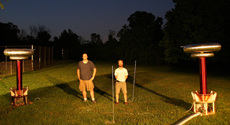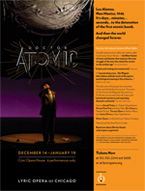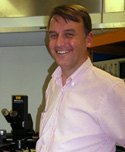|
Wednesday, Nov. 28
8:30 a.m. - 3:30 p.m.
CMS SLHC Tracker Upgrade Workshop - One West
Also available on (video conference) EVO under CMS community
THERE WILL BE NO FERMILAB ILC R&D MEETING THIS WEEK
3:30 p.m.
DIRECTOR'S COFFEE BREAK - 2nd Flr X-Over
4 p.m.
Fermilab Colloquium - One West
Speaker: P. Kwiat; University of Illinois, Urbana-Champaign
Title: The Quantum Information Revolution: 101 Uses for Schroedinger's Cat
Thursday, Nov. 29
THERE WILL BE NO ILC ALCPG PHYSICS AND DETECTOR R&D SEMINAR THIS WEEK
2:30 p.m.
Theoretical Physics Seminar - Curia II
Speaker: B. Batell, University of Minnesota
Title: Warped Extra Dimensions and Partial Compositeness
3:30 p.m.
DIRECTOR'S COFFEE BREAK - 2nd Flr X-Over
4 p.m.
Accelerator Physics and Technology Seminar - One West
Speaker: R. Assmann, CERN
Title: Beam Loss and Collimation at the LHC
Click here for NALCAL,
a weekly calendar with links to additional information. |
Wednesday, Nov. 28
- Portabello harvest grain
- Santa Fe chicken quesadilla
- Hoisin chicken
- Beef stroganoff
- Cuban panini
- Assorted slice pizza
- Pesto shrimp linguini w/leeks & tomatoes
Wilson Hall Cafe Menu |
|
Wednesday, Nov. 28
Lunch
- Rouladen
- Egg noodles
- Carrots w/dill
- Linzentorte
Thursday, Nov. 29
Dinner
Closed
Chez Leon Menu
Call x4598 to make your reservation. |
|
|
Fermilab technician, U of I student make Tesla coils sing

University of Illinois student Steve Ward (left) and Fermilab senior technician Jeff Larson stand between their twin, seven foot tall Tesla coils. Click on the photo to view one of the singing Tesla coil videos.
Tesla coils attract attention. The arcane, high-voltage technology that drives them powered the very first particle accelerator in 1928 and today, it is used in television picture tubes and in the backyards of amateur enthusiasts. So it was no surprise to find a Tesla coil at the DucKon science fiction convention in Naperville last June. A crowd gathered ready to hear the typical crackle and watch the purple sparks.
But the coil began to take on a life of its own. Its pitch and frequency fluctuated, and as the sound started and stopped, musical notes began to emerge. Someone in the crowd held up a lighter while another listener shouted out a musical request for the Lynyrd Skynyrd song "Free bird."
Thanks to that premier performance and videos on YouTube, the singing Tesla coils' creators Steve Ward, a student at University of Illinois-Urbana, and Jeff Larson, a senior technician at Fermilab, have become the rock stars of the Tesla coil universe. Their first YouTube video has received almost a million hits.
Larson estimates that a few dozen Tesla coils make music, and most of those are small. "Our set up got so much attention because it was so big," he said. "Most musical Tesla coils are only a few feet high and shoot sparks that are a couple of feet long. We can produce 12 feet of spark with ours."
After Ward mastered the original Tesla coil, Larson built a twin. "They can play in chorus or as a duet," said Ward, who has written music for the Tesla coils to play.
Together, the musical Tesla coils can play everything from the theme to the Mario Brothers video game to the "Dance of the Sugar Plum Fairy."
The music is created when a laptop computer signals the coil to produce a spark, which heats the air making a popping noise. Sparks emitted in rapid succession create a buzz and eventually a musical note. Ward and Larson control the frequency of the sparks to create whole songs. The music is so loud that some audience members can't believe that it is the Tesla coils' sparks that are responsible for the song they are grooving to.
"People came up to me asking, 'Where are the speakers?' and there aren't any," Larson said.
-- Haley Bridger

Ward and Larson's twin Tesla coils stand seven feet high and are capable of emitting 12 feet of spark.
|
Robert Wilson hits
the stage in atomic opera
 |
| The opera "Dr. Atomic" features Fermilab founder Robert Wilson. |
Although Robert Wilson is best known to us for his integral role in founding Fermilab, details of earlier portions of his life will be highlighted on stage this holiday season.
Beginning Dec. 14, Wilson's time at Los Alamos and his role in creating the atomic bomb will bloom as part of "Dr. Atomic", an operatic production at the Lyric Opera in Chicago. The show performs through mid January.
It has been more than 60 years since the bomb was dropped, but director Peter Sellars takes viewers back to Los Alamos in 1945. The production begins three weeks before the bomb's detonation and continues until the final countdown, all the while following the inner struggles of the scientists involved.
Originally constructed in 2005 by composer John Adams and librettist Peter Sellars, the opera illuminates the inner lives of the characters, bringing their yearnings, doubts and misgivings into the light as they release the most destructive device ever made. The opera puts Wilson at the forefront of protest. He's helped to build the bomb, but the thought of its destructive power leads him to rally the scientists to consider the ethics of the project. Wilson vow to work on peaceful uses of atomic energy for the rest of his life.
Constructed from information contained in declassified documents, interviews with Manhattan Project veterans, letters, poetry, reports and other literary items, the opera is an expressive piece of our history.
"This is the real stuff - the real science, real history, the story of America, the story of the planet," said Sellars.
"Dr. Atomic" opens at the Lyric Opera of Chicago on Dec. 14 and runs though Jan. 19. Tickets range in price from $31 to $187. For more information or to order tickets, call (312) 332-2244 or visit www.lyricopera.org.
|
Geometry is all
From The Economist, Nov. 22, 2007
A shape could describe the cosmos and all it contains
One of the mysteries of the universe is why it should speak the language of mathematics. Numbers and the relationships between them are, after all, just abstract reasoning. Yet mathematics has shown itself to be particularly adept at describing both the contents of the universe and the forces that act on them. Now comes a paper which argues that one branch of the subject-geometry-could form the basis of all the laws of physics.
Physicists are an overbearing bunch. They have long sought a "theory of everything". Such an opus would unite the fundamental forces-gravity, electromagnetism and the two forces that become apparent only at the atomic scale-with the matter on which they act, in a single, overarching framework. It would describe the universe as it existed at the moment of its creation in the Big Bang.
Read More
|
|
|
Fiscal planning
Today's column is written by Particle Physics Division head Jim Strait.
 |
| Jim Strait |
This is an important time of the year for division managers, as we work with the Directorate to establish the fiscal year budget. This potentially dry exercise, driven by large and complicated spreadsheets, is an extremely important planning process for the year ahead. The many different PPD departments, groups and projects, which operate quite independently for much of the year suddenly find that they are "joined at the hip" by the common Division budget. Program managers have plans for what they hope to do this year. Unfortunately, both financial and personnel resources are finite. Priorities are discussed among PPD leaders and between PPD managers and the Directorate to ensure that we make the best use of our resources.
The process formally begins when the Directorate gives budget guidance, which specifies an overall budget for PPD general operations, and calls out specific amounts for certain projects and programs. Those pre-specified amounts reflect that we are responsible for projects and programs central to the laboratory's mission: CMS, NOvA, MINERvA, the Dark Energy Survey, and ILC Detector R&D.
Department heads and project leaders send both material and personnel budget requests to the division office. We try to fit the requests within the budget guidance, and then try to match personnel support requests with the people available in PPD. We are now engaged in a series of discussions with department heads and program leaders, to find a plan that allows us to accomplish as much science as possible within the budgetary constraints.
This process will culminate with a formal presentation of the PPD budget to the Directorate next week. We will explain what we can do with the budget they have given us, and, very importantly, what we cannot do. This is our opportunity to appeal for more funds that would allow lower-priority, but still important, programs to go forward. After all of the divisions, sections and centers have presented, the Directorate makes the final decisions, establishing priorities within the final budget for each organization.
This process can be quite stressful, but it helps ensure that the laboratory spends its money wisely and efficiently, and it is an important method of communication for needs and priorities across all levels of the laboratory.
|
Collision courses
From The New York Times, Nov. 22, 2007
Q. The most powerful particle collider, the Large Hadron Collider, will begin to operate in 2008 at 14 trillion electron volts. The next collider to be built, the International Linear Collider, will operate at only 0.5 trillion electron volts. Why are we going backward in collider energy levels?
A. The smaller energy needs of the linear collider do not represent a step backward, just a different way of looking at the nature of matter. The two colliders are looking for different information about the nature and interaction of elementary particles that make up the material world.
The larger one is trying to bang beams of protons together at great energy in the hope of shaking out one tiny "marble" from the jumbled bag of particles called quarks and gluons that make up the proton. The target is the elusive Higgs boson, which theoretical physicists believe endows all the other constituents of nature with mass.
Read More
|
New hires
New hires Nov. 12-27
- April Cook - operator - AD
- Kirk Skaar - computer professional - PPD
|
ES&H weekly report, Nov. 27
This week's safety report, compiled by the Fermilab ES&H section, includes no reportable cases. Fermilab has now worked 53 days
since its last OSHA recordable injury. The full report is here.
Safety report archive
|
|
Have a safe day!
NALWO holiday Chicago trip Dec. 1
Join NALWO on Saturday, Dec. 1, on a trip to Chicago to see colorful
decorations and enjoy shopping, music and entertainment at the German/American holiday festival, the "Christkindlmarket" at Daley Plaza. Shop at the State Street department stores, see Macy's animated windows or try your skills at the Ice Skating Rink at Millennium Park. The bus will leave from the Lederman
Science Center at 10 a.m. and will return by 4:30 p.m. There is a $5 charge for adults and $2 for kids age 3 to 14. To register or for further
information, please contact Selitha Raja at (630) 305-7769.
Benefit enrollment
Today, Wednesday, Nov. 28, is the final day to review and change your benefits for the 2008 plan year.
You will find enrollment materials on the Benefits Office Web site. Representatives from Blue Cross and CIGNA will be available on Wednesday, Nov. 14, from 8 a.m. to noon and Tuesday, Nov. 20, from 1 to 5 p.m. They will be located in the Aquarium Conference Room on the 15th floor of Wilson Hall.
Seasonal holiday student requests
Managers who would like to bring back their summer students for holiday seasonal employment can access information and a request form here. Only students who were summer 2007 employees are eligible. Students who were on-call must return as on-call workers.
Education Office holiday sale Dec. 4-6
The Education Office will host its annual holiday sale Dec. 4-6, from 11 a.m. to 1:30 p.m., outside One West in Wilson Hall.
Fermilab Basketball League
Basketball League play begins on Nov. 29 in the gymnasium at the Recreation Facility. Games are played Thursday evenings beginning at 5 p.m. Contact Ryan Schultz at X6571 or e-mail if you are interested in participating. Current Recreation Facility membership required.
Additional Activities
|
|



